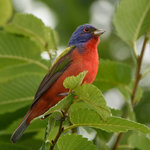

By Sherry Lucas
When pandemic shelter-at-home orders left many stuck at the house last spring, who was still on the move? Birds.
Migrating beauties and backyard residents were about the only ones swooping by for a visit, and folks responded accordingly. Bird-watching has soared nationwide during the pandemic. Apps such as eBird, to help keep a checklist of sightings, and the info-packed Merlin Bird ID and Audubon Bird Guide can be a big help in supporting the newfound passion.
“We’re encouraging people to get out and bird-watch, but practice physical distancing, wear a mask,” and don’t share binoculars or spotting scopes, says ornithologist Mark Woodrey, based at the Mississippi State University Coastal Research and Extension Center in Biloxi and president of the Mississippi Coast Audubon Society.
While organized weekend field trips are on hiatus during the pandemic, several Facebook pages and a ListServe are keeping birders connected. The recent sighting of a gray kingbird, typically found in the Caribbean, generated excitement and enticed several people to drive down and see the bird, Woodrey says.
Long Beach birding enthusiast Dave Reed was one of them, catching up with Woodrey at Popp’s Ferry Causeway Park to get a look at the gray kingbird.
“We also found out it was nesting,” he says, after following its flight into a tree’s foliage and, through binoculars, finally locating the branch it was on and spotting the bird’s head on a nest. “Hopefully, we’ll have some baby kingbirds.”
“It’s always good to find birds that are fairly rare for the area,” says Reed, who also wraps bird photography into his hobby.
This marks only the second nesting record for the gray kingbird in the entire state, Woodrey notes.
“Interestingly enough, the other record, in the early ‘90s, was also in Biloxi, but not in this same place.”
Bird-watching is an easy, relaxing pursuit that can add color, interest and intrigue to porch sitting, neighborhood strolls, day trips and vacations.
“You don’t have to have an expensive pair of binoculars,” Reed says. “Find a field guide, and you can walk in your neighborhood and learn quite a bit.”
Woodrey has these tips to enhance bird attraction, sightings and your own enjoyment:
Plant native species in your yard — Native plant species host more insects than do ornamental species, which means more food choices for the birds, plus more shelter in restored habitat. That translates to better health, condition and reproductive success for the birds. Bonus: Native plants typically require less attention, watering and pruning.
“The biggest thing I try to remind people is that you want to have as little grass as possible.”
Provide cover — A big open yard is not nearly as effective as trees and shrubs for attracting birds.
Entice with fresh water — “Water, particularly this time of year, is really important,” Woodrey says. Birdbath water can get dirty, so get out the hose with a spray nozzle to rinse them out and replace with fresh water periodically. Remember, “If it gets too bad, they won’t come and use it.”
Water drips tend to attract birds’ attention, so rig up a drip if possible. There are birdbath dripper kits at the big box stores. You could also fashion your own, with a dripping hose hanging over the birdbath, or, as Woodrey did, with a cleaned-out gallon milk jug and tiny hole, dripping steadily through the daylight hours.
Put out the food — Black oil sunflower seeds are the best all-around seeds for people wanting to attract seed-eating birds.
For hummingbirds, dissolve one part sugar to four parts water to fill hummingbird feeders. Any bird feeder that has red or purple details (add pink or red ribbon if it doesn’t) should get their attention. Hummingbirds don’t nest within 10 to 15 miles of the coastline, so spring and fall migration times — April and late August/September — are the best times to catch sight of them.
Expand your horizon — Stay active and learning on the bird front, through involvement with the coastal bird community.
The Mississippi Coast Audubon Society follows state, CDC and National Audubon mandates and recommendations during the COVID-19 pandemic (no indoor meetings or sponsored field trips for now), but offers these ways to get and stay connected: Like and follow the Facebook pages of the Mississippi Coast Audubon Society, Audubon Mississippi Coastal Bird Stewardship and Pascagoula River Audubon Center; join the private Facebook group Mississippi Gulf Coast Band of Birders; join the email list Missbird through the Mississippi Ornithological Society; use eBird to track bird observations and see what others are seeing nearby; use the iNaturalist app to post bird photos and sound files; and check out the possibilities of the Mississippi Coastal Birding Trail (but double-check that trails are open).